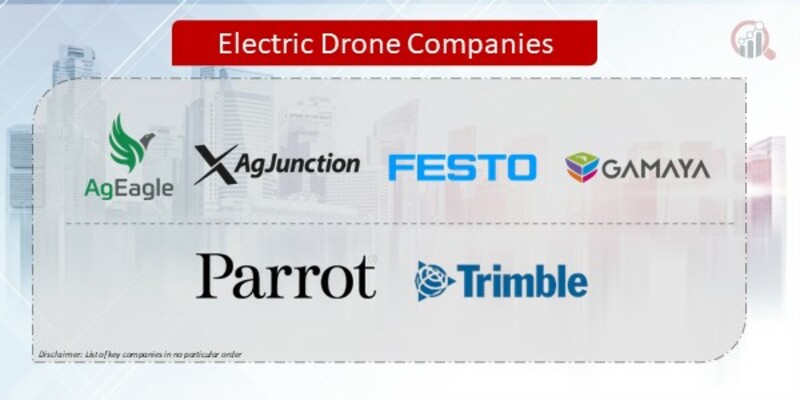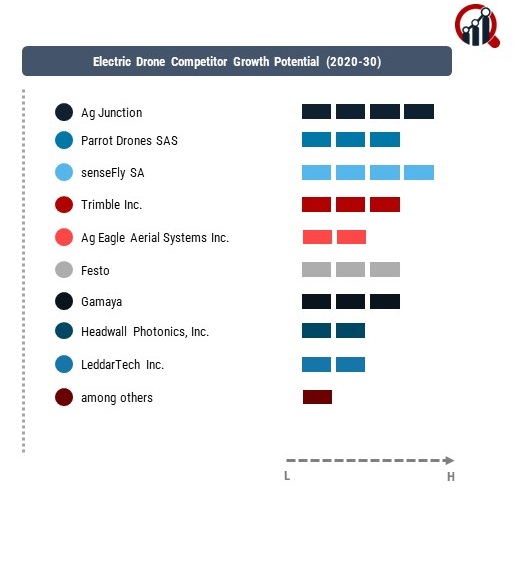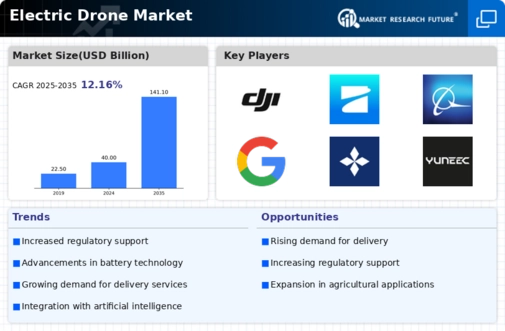Top Industry Leaders in the Electric Drone Market

Strategies Adopted: In the fiercely competitive Electric Drone market, key players employ strategic approaches to maintain a competitive edge. Continuous investment in research and development (R&D) is crucial, allowing companies to introduce next-generation electric drones with enhanced flight performance, longer endurance, and advanced sensing capabilities. Strategic collaborations with industries such as agriculture, surveying, and logistics facilitate the development of specialized drone solutions tailored to specific applications. Global market expansion is achieved through partnerships with regulatory bodies, participation in pilot programs, and establishing strong distribution networks, ensuring a broad market reach and allowing companies to address the diverse needs of end-users worldwide.
Competitive Landscape of Electric Drone Market
- AgJunction (US)
- Parrot Drones SAS (France)
- senseFly SA (US)
- Trimble Inc. (US)
- AgEagle Aerial Systems Inc. (US)
- Festo (Germany)
- Gamaya (Switzerland)
- Headwall Photonics Inc. (US)
- LeddarTech Inc. (Canada)
Factors for Market Share Analysis: Market share analysis in the Electric Drone market involves considering various factors crucial to a company's competitive standing. Technical capabilities, such as offering a comprehensive range of electric drones covering various categories, from consumer drones to commercial-grade UAVs, play a pivotal role. Companies providing adaptable and customizable drone solutions capable of addressing diverse industry requirements are better positioned to capture a larger market share. Compliance with stringent aviation regulations, safety features, and integration of advanced technologies such as artificial intelligence and computer vision contribute significantly to market share dynamics. Additionally, factors like battery technology, flight time, and payload capacity influence a company's market share by enhancing the overall value proposition for drone users seeking efficient and sustainable aerial solutions.
New and Emerging Companies: While established players dominate the market, new and emerging companies are entering the Electric Drone sector, contributing to innovation and market diversification. Companies like Skydio and Wingcopter are gaining recognition for their specialized drone solutions, often focusing on autonomous flight capabilities, innovative designs, and addressing niche applications such as drone delivery. Emerging companies often bring agility and fresh perspectives to the Electric Drone market, introducing novel approaches and technologies that cater to the evolving demands of modern industries and consumers.
Industry News: Recent industry news in the Electric Drone market underscores ongoing developments and trends shaping the sector. Innovations in drone swarming technology, advancements in autonomous navigation systems, and the integration of 5G connectivity for real-time data transmission are gaining prominence. News often covers developments in drone applications for environmental monitoring, disaster response, and precision agriculture. Additionally, advancements in urban air mobility concepts and the use of drones for medical deliveries highlight the industry's commitment to pushing the boundaries of drone capabilities. Industry news reflects the dynamic nature of the Electric Drone market, with continuous efforts to improve efficiency, sustainability, and the overall functionality of unmanned aerial vehicles.
Current Company Investment Trends: Investment trends in the Electric Drone market underscore a commitment to technological innovation, sustainability, and global market reach. Companies are allocating substantial resources to R&D initiatives focused on electric propulsion systems, energy-efficient designs, and advanced collision avoidance technologies. Investments in software development for mission planning, data analytics, and drone management systems align with the industry's broader push towards digitalization. Strategic acquisitions of technology startups, partnerships with research institutions, and collaborations with regulatory bodies contribute to a comprehensive approach, ensuring a continuous stream of cutting-edge solutions and maintaining a competitive stance in the market.
Overall Competitive Scenario: The overall competitive scenario in the Electric Drone market reflects a balance between established industry leaders and emerging companies that bring innovation and flexibility to the sector. Established drone manufacturers leverage their extensive experience, global reach, and comprehensive drone portfolios to set industry standards. Simultaneously, emerging companies contribute to the diversification of Electric Drone solutions, often focusing on specific applications or introducing disruptive technologies. The industry's response to evolving market demands, technological advancements, and the integration of advanced features into electric drones highlights the adaptability and resilience of Electric Drone providers. As industries and consumers globally seek more advanced, sustainable, and versatile drone solutions, the Electric Drone market is poised for continued evolution. The emphasis on technological advancements, strategic collaborations, and meeting the dynamic needs of modern applications positions this market as a critical enabler for efficient, sustainable, and transformative aerial capabilities.
Recent Development:
January 2021, AeroVironment, Inc. announced the acquisition of Arcturus UAV, Inc. for a sum of USD 405 million. Arcturus UAV, Inc. specializes in the production of comprehensive unmanned aerial systems.
During the same month, the Indian Army awarded a USD 20 million contract to idea Forge Technology Pvt. Ltd. The contract aims to develop high-altitude SWITCH unmanned aerial vehicles (UAVs). These UAVs, equipped with fixed wings capable of vertical take-off and landing, are designed for day and night surveillance in challenging conditions, particularly at high altitudes. The SWITCH UAV proves valuable for Intelligence, Surveillance, and Reconnaissance (ISR) operations.
January 2021, the Federal Aviation Administration (FAA) granted American Robotics, Inc. permission to operate fully automated drones without human presence on board. This development marks a significant step by the FAA toward establishing a system for efficiently managing the traffic of unmanned aircraft.










